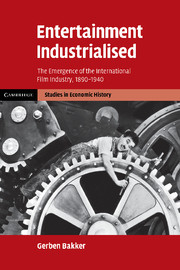Part II - The rise of the international film industry
Published online by Cambridge University Press: 08 July 2009
Summary
It is safe to say that in the future, the bulk of motion picture production will be done within easy reach of Manhattan.
Wall Street Journal, 7 April 1924.By the end of the nineteenth century the average citizen in the US, Britain or France could enjoy a greater amount and variety of pleasures than ever before. While a century earlier a large part of live entertainment had been restricted or forbidden, and the supply had been limited to pantomime, magicians and other non-spoken performances at fairs and random occasions, now a regular supply existed through venues such as music halls, theatres, pubs, cafés-concerts, vaudeville or burlesque houses and small penny gaffs. The quantity and variety seemed almost infinite, and the price was low enough to bring the regular enjoyment of at least some kind of amusement within the reach of many.
The previous part began with an examination of the evolution of live entertainment production and consumption after the liberalisations of the late eighteenth and the nineteenth centuries. The deregulations led to strong growth throughout the century and to the development of new technologies, such as larger theatres with higher seating capacities, mechanic staging techniques, heavily promoted extravagant productions, an increase in the length-of-run of plays and duplication by puppet theatres. Increasing overhead costs reflected the increasing scale and specialisation of theatres.
Deregulation also led to changes in the organisation of the theatre industry.
- Type
- Chapter
- Information
- Entertainment IndustrialisedThe Emergence of the International Film Industry, 1890–1940, pp. 153 - 158Publisher: Cambridge University PressPrint publication year: 2008

